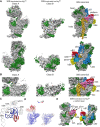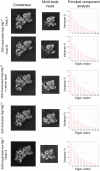Alternative conformations and motions adopted by 30S ribosomal subunits visualized by cryo-electron microscopy
- PMID: 32989043
- PMCID: PMC7668263
- DOI: 10.1261/rna.075846.120
Alternative conformations and motions adopted by 30S ribosomal subunits visualized by cryo-electron microscopy
Abstract
It is only after recent advances in cryo-electron microscopy that it is now possible to describe at high-resolution structures of large macromolecules that do not crystalize. Purified 30S subunits interconvert between an "active" and "inactive" conformation. The active conformation was described by crystallography in the early 2000s, but the structure of the inactive form at high resolution remains unsolved. Here we used cryo-electron microscopy to obtain the structure of the inactive conformation of the 30S subunit to 3.6 Å resolution and study its motions. In the inactive conformation, an alternative base-pairing of three nucleotides causes the region of helix 44, forming the decoding center to adopt an unlatched conformation and the 3' end of the 16S rRNA positions similarly to the mRNA during translation. Incubation of inactive 30S subunits at 42°C reverts these structural changes. The air-water interface to which ribosome subunits are exposed during sample preparation also peel off some ribosomal proteins. Extended exposures to low magnesium concentrations make the ribosomal particles more susceptible to the air-water interface causing the unfolding of large rRNA structural domains. Overall, this study provides new insights about the conformational space explored by the 30S ribosomal subunit when the ribosomal particles are free in solution.
Keywords: 30S subunit; cryo-electron microscopy; ribosome structure.
© 2020 Jahagirdar et al.; Published by Cold Spring Harbor Laboratory Press for the RNA Society.
Figures






Similar articles
-
Role of Era in assembly and homeostasis of the ribosomal small subunit.Nucleic Acids Res. 2019 Sep 5;47(15):8301-8317. doi: 10.1093/nar/gkz571. Nucleic Acids Res. 2019. PMID: 31265110 Free PMC article.
-
Major rearrangements in the 70S ribosomal 3D structure caused by a conformational switch in 16S ribosomal RNA.EMBO J. 1999 Nov 15;18(22):6501-7. doi: 10.1093/emboj/18.22.6501. EMBO J. 1999. PMID: 10562562 Free PMC article.
-
Using a targeted chemical nuclease to elucidate conformational changes in the E. coli 30S ribosomal subunit.Biochemistry. 2000 Apr 11;39(14):4068-74. doi: 10.1021/bi992362t. Biochemistry. 2000. PMID: 10747796
-
RNA-protein interactions in 30S ribosomal subunits: folding and function of 16S rRNA.Science. 1989 May 19;244(4906):783-90. doi: 10.1126/science.2658053. Science. 1989. PMID: 2658053 Review.
-
Cryo-electron microscopy as an investigative tool: the ribosome as an example.Bioessays. 2001 Aug;23(8):725-32. doi: 10.1002/bies.1102. Bioessays. 2001. PMID: 11494321 Review.
Cited by
-
30S subunit recognition and G1405 modification by the aminoglycoside-resistance 16S ribosomal RNA methyltransferase RmtC.Proc Natl Acad Sci U S A. 2023 Jun 20;120(25):e2304128120. doi: 10.1073/pnas.2304128120. Epub 2023 Jun 12. Proc Natl Acad Sci U S A. 2023. PMID: 37307464 Free PMC article.
-
Structural basis of sequestration of the anti-Shine-Dalgarno sequence in the Bacteroidetes ribosome.Nucleic Acids Res. 2021 Jan 11;49(1):547-567. doi: 10.1093/nar/gkaa1195. Nucleic Acids Res. 2021. PMID: 33330920 Free PMC article.
-
RbfA Is Involved in Two Important Stages of 30S Subunit Assembly: Formation of the Central Pseudoknot and Docking of Helix 44 to the Decoding Center.Int J Mol Sci. 2021 Jun 7;22(11):6140. doi: 10.3390/ijms22116140. Int J Mol Sci. 2021. PMID: 34200244 Free PMC article.
-
KsgA facilitates ribosomal small subunit maturation by proofreading a key structural lesion.Nat Struct Mol Biol. 2023 Oct;30(10):1468-1480. doi: 10.1038/s41594-023-01078-5. Epub 2023 Aug 31. Nat Struct Mol Biol. 2023. PMID: 37653244 Free PMC article.
-
Stabilization of Ribosomal RNA of the Small Subunit by Spermidine in Staphylococcus aureus.Front Mol Biosci. 2021 Nov 18;8:738752. doi: 10.3389/fmolb.2021.738752. eCollection 2021. Front Mol Biosci. 2021. PMID: 34869582 Free PMC article.
References
-
- Adams PD, Afonine PV, Bunkoczi G, Chen VB, Davis IW, Echols N, Headd JJ, Hung LW, Kapral GJ, Grosse-Kunstleve RW, et al. 2010. PHENIX: a comprehensive Python-based system for macromolecular structure solution. Acta Crystallogr D Biol Crystallogr 66: 213–221. 10.1107/S0907444909052925 - DOI - PMC - PubMed
MeSH terms
Substances
LinkOut - more resources
Full Text Sources
